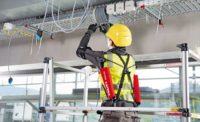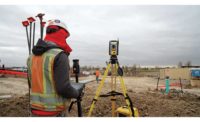Overhead drilling is one of the most strenuous tasks in the building trades, and there have been several attempts to lessen the strain on workers responsible for drilling hundreds of holes overhead in concrete. Not content with bringing out a mechanical exoskeleton earlier this year and stopping there, tool manufacturer Hilti is now launching a semi-autonomous overhead drilling robot.
The robot, called Jaibot, features a robotic arm mounted to a tracked base unit. While the unit is driven around the site by a nearby operator with a control unit, the robot will orient itself at the drill site and drill autonomously once paired with an included Hilti PLT 300 robotic total station.
With the project BIM data loaded in and the PLT 300 used for positioning, the robot is able to drill all of the overhead holes in the concrete slab within a 6 ft dia. The robotic arm features six points of actuation and can operate within a full 360° envelope.
Equipped with a standard Hilti TE 6-A22 cordless rotary hammer drill, the robot can drill holes from 3/16 in. to 3/4 in. in dia, in all the standard sizes used for MEP installations. Once the operator has driven the robot to the work zone, they need only raise the robotic arm to height to begin drilling.
After a hole is completed, the robot will mark the hole with a built-in spray paint function, using different patterns to signify overhead holes for different building trades. With an eight-hour runtime, the robot is capable of drilling hundreds of overhead holes in a single shift.
The robot arrives in a standard shipping container that also serves as its overnight charging station. The track-mounted base includes the dust-collection system for the drill, as well as storage for spare bits and other tools. The robot is less than 3 ft wide and under 5 ft tall, allowing it to maneuver through most indoor spaces. According to Hilti, operating the robot does not require extensive training or previous experience in working with BIM documents.
While semi-automated machines have performed construction tasks in the past, Hilti sees this particular robot as part of a larger digitization of the jobsite. “Jaibot fed live design data from the cloud … it syncs with design changes,” explains Aidan Maguire, Hilti North America business unit manager for measurement. Design files are loaded in wirelessly via Hilti's ruggedized PLC 400 jobsite tablet, or downloaded from Hilti's cloud service. The Jaibot currently supports design files uploaded from Revit and AutoCAD.
While the human operator is usually only needed to reposition the robot between work areas, they can override the programmed design model if there is a problem, like unexpected rebar uncovered where a hole needs to go. “The operator can make the decision to skip a hole if required, and that information is sent back into the cloud and the office,” adds Maguire.
“This is another step into fully realizing the BIM-to-field concept,” explains Rafael Garcia, vice president of sales and marketing for Hilti North America. “Contractors will be able to more seamlessly get information from design to execution with the Jaibot to record exactly what and where has been drilled on site for progress monitoring and documentation of work completed.”
While the initial Jaibot will only come with a hammer drill for overhead MEP hole drilling, Maguire says Hilti is exploring other possible attachments and applications for the robot. “[The drill] is a modular attachment at the end of the arm,” he says, which can aid in maintenance and swapping out drills, and eventually other tools. “In the future, customers invested in the Jaibot platform would be able to upgrade,” he says, adding either new hardware attachments or even new capabilities through software updates. “There is almost an endless range of applications to target with robotics and automation on the jobsite," observes Maguire.
Garcia adds that the Jaibot is the result of a multiyear development cycle within Hilti, and there are other robotic products on the horizon. “We’re excited at what is in the pipeline for [our] robotic R&D. Jaibot is just the first.”
A price has not been announced, but Garcia says the initial deployments will involve providing Jaibot as a service to select partners, rather than retail purchases.








